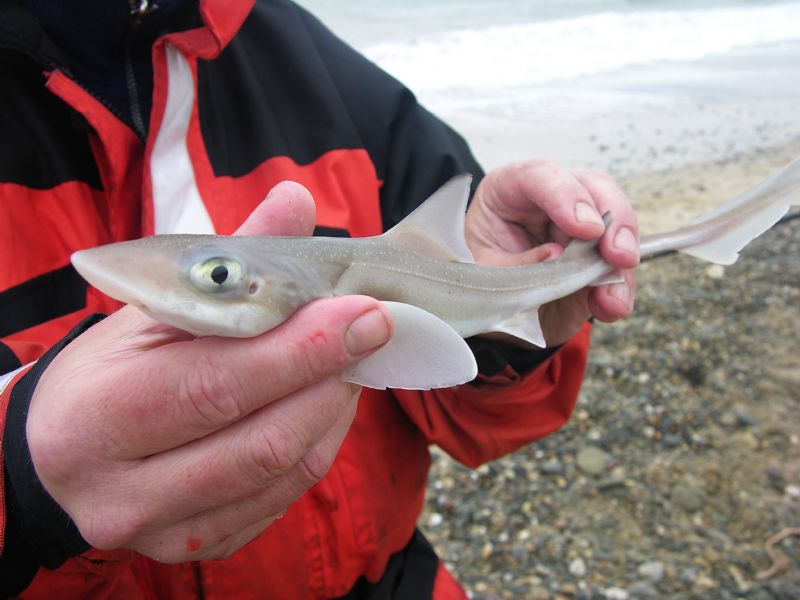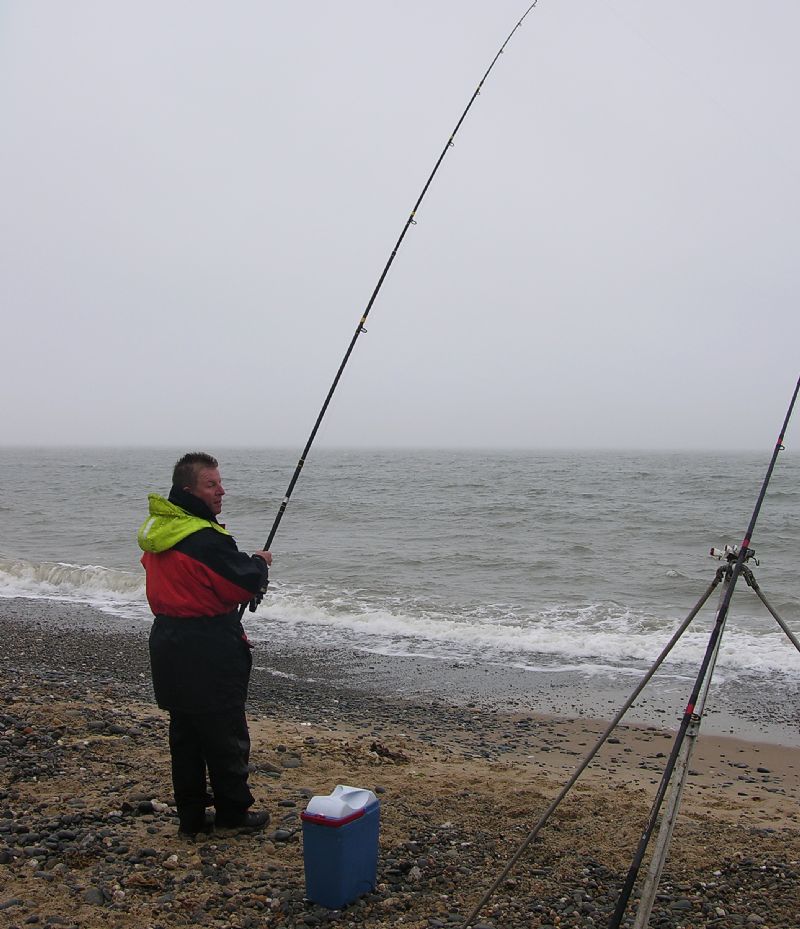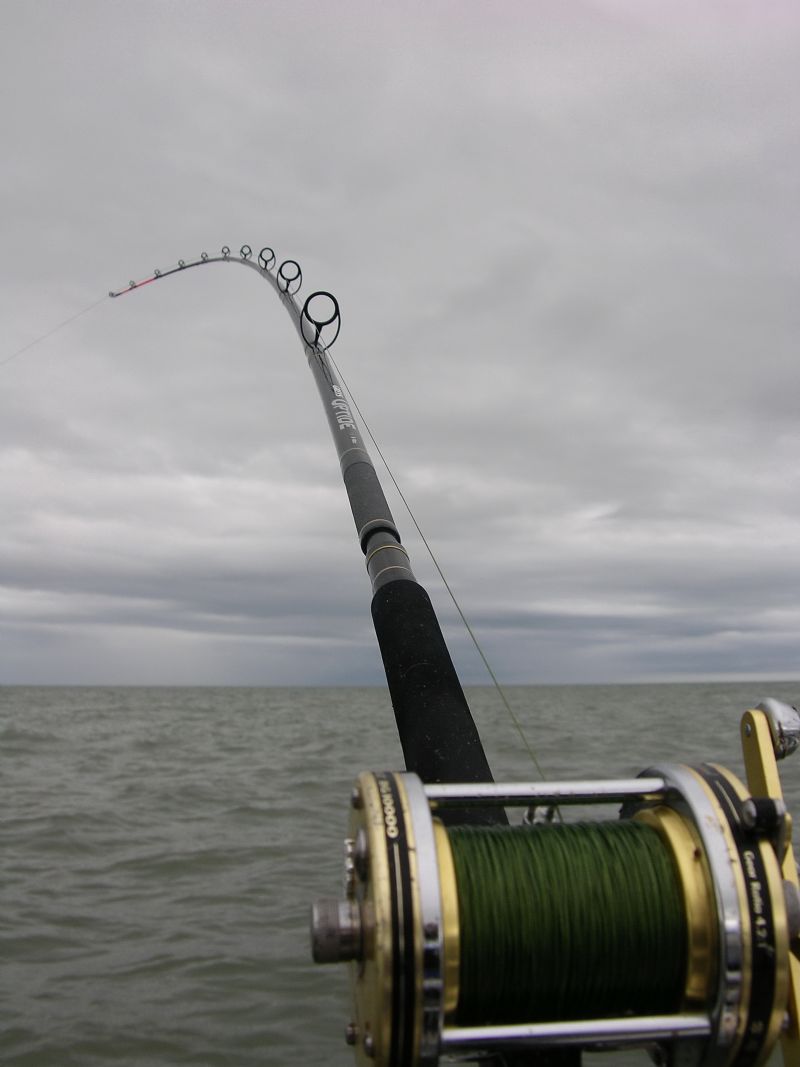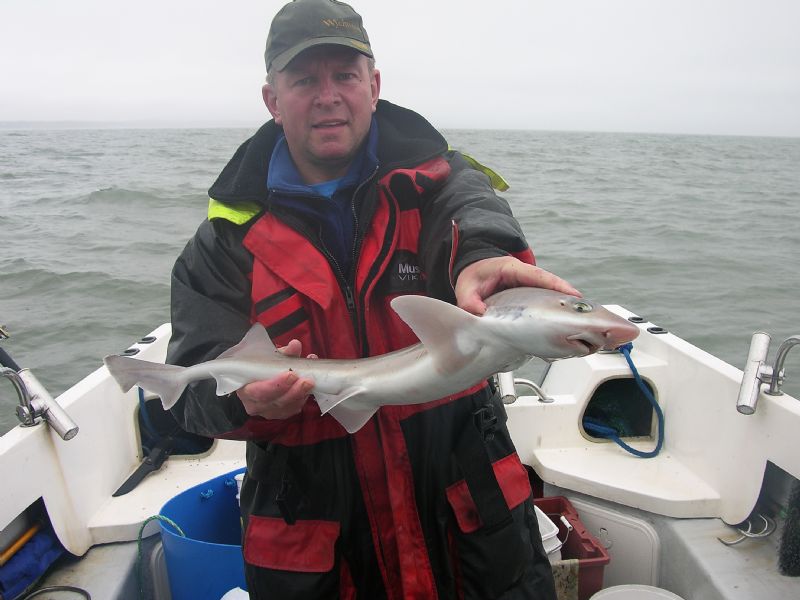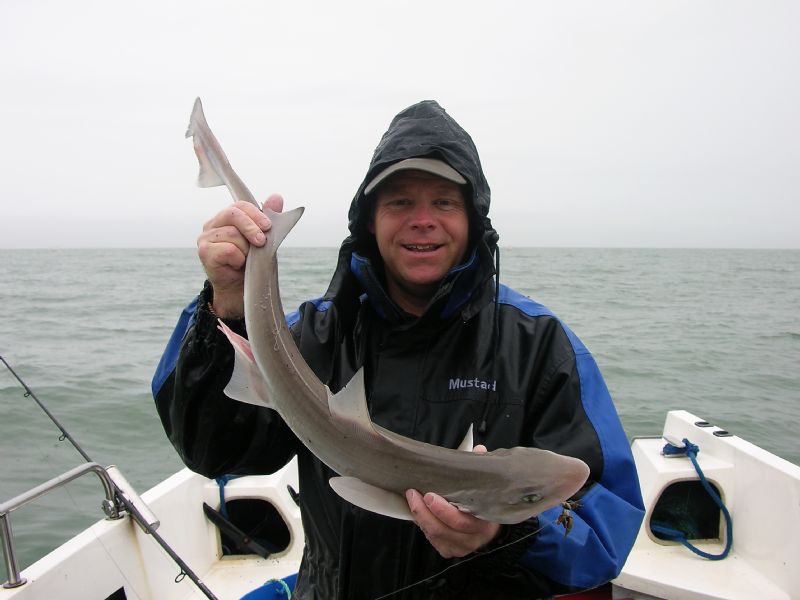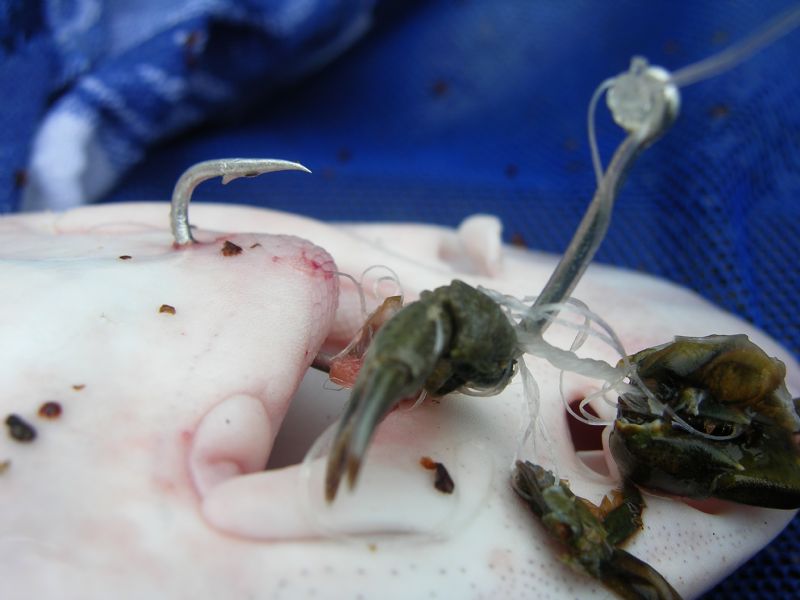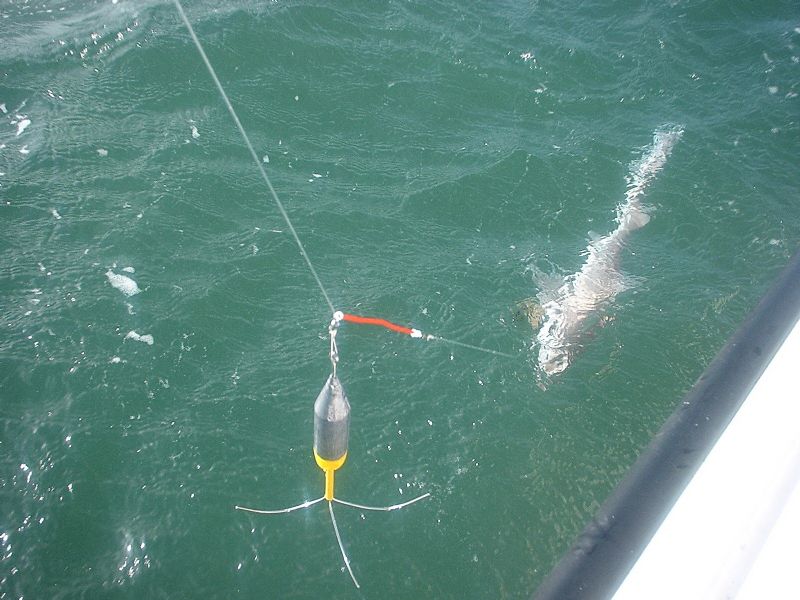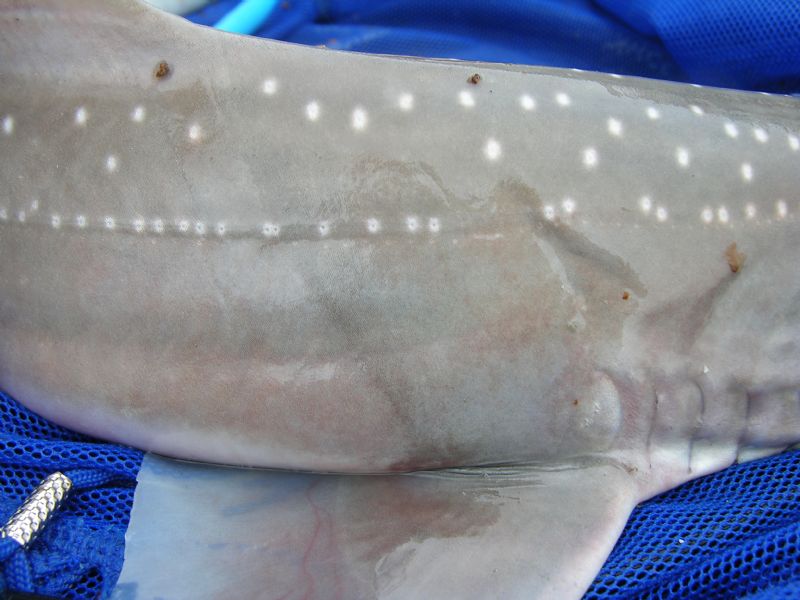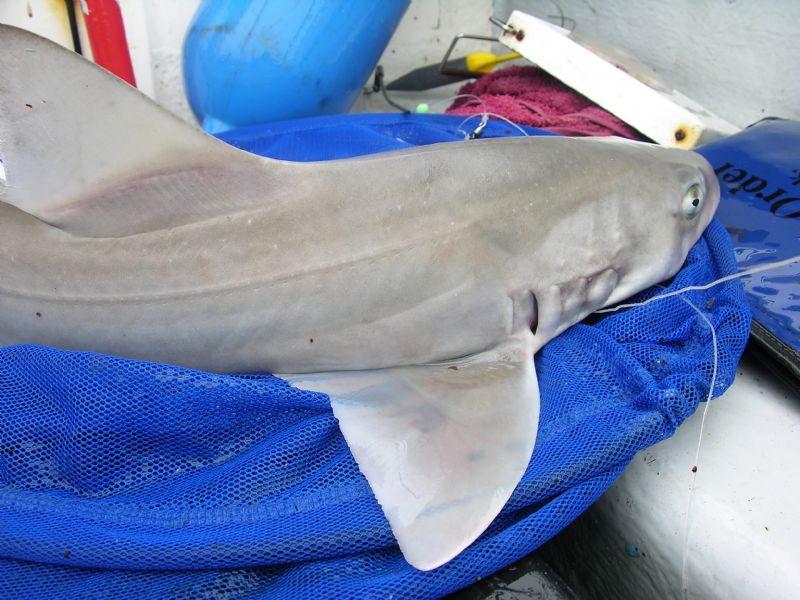Species hunt part 7 Smooth Hound
Smooth hound
Fact file
Name Smooth-hound (ID info click here)
Latin name Mustelus asterias
Irish record 16.58 lbs taken on 25.09.2000 at Carne by Keith Gray
Specimen weight 7 lbs or 3.175 kilos
The trip
In order to catch a Smooth hound for this month's target species, there was no getting around the fact that I needed to travel. They have been known to migrate as far north as Dundalk, but any further north and the depths increase dramatically, with seabed habitat generally becoming unsuitable. My favourite Smooth hound areas are the inshore Wexford, Wicklow and Arlow marks, and like it or not, the five hour journey required for a successful outcome was un-avoidable.
Obviously, with boat in tow, this is not a trip that can be carried out in a single day, and so, as usual, my plans were rapidly turning into a mini adventure. For company, my long time shore angling mate, Garry Gregg agreed to tag along, as he rarely has the opportunity to catch a “smoothie”, and was looking forward to rectifying this. The plan was to find Smooth hound from the boat, but also to bring along the beach gear should the weather deteriorate. From experience, the one thing you learn regarding Irish weather is to have a contingency plan.
On arrival at the harbour, there was enough time to get organised, set up our bivvies, nip up to the pub for a night cap, and chat about the following day. The radio forecast gave un-settled weather, and the added touch of easterly wind is never promising. Already committed, there was no choice but to wait and see what the morning would bring. A couple of pints later, and a splash of sea water to keep the peeler crab happy and it was time to crash out in our respective tents to think of hard fighting specimen Smooth hound the following day.
With the weather deteriorating, all we could do was hit the shores
By morning, and after a healthy Ulster fry cooked up by yours truly, the weather had worsened and it was obvious the boat was staying put. Just as well that we had the foresight to bring the beach gear with us. With the boat and trailer securely chained up for peace of mind, we scanned the map and decided on trying a “beachy” headland several miles north of the harbour. Without any shore experience in this area, it was picked purely on the basis that it jutted out to sea a little further, and ran alongside a rocky outcrop that just looked “fishy”.
Although juveniles, and like peas in a pod, we found our target species
Garry was in his element, and was soon dropping peeler crab-baited hooks over the horizon. He is an accomplished distance caster and put my casting efforts to shame. Hopefully on this occasion, prime fresh peeler would be the focus, and not casting ability. A nod on the rod tip, and Garry had first blood, and indeed, it was a perfectly formed, mini Smooth hound. Another two followed in quick succession before I joined in, but although this run of fish were tiny, it was extremely satisfying to see a species that are not available on our local shore marks in the north. By the end of the session, we ended up with fifteen pups, all like peas from a pod, and a couple of the usual obligatory Dogfish.
I remember thinking that at least we managed to find a few for the camera, and saved a blank day. By late afternoon, the weather had deteriorated further, and on return to the harbour, our bivvies were a sorry sight to say the least. Although I was willing to make the most of it, Garry refused to spend a night in a soaked and windswept nylon hut! In fairness, he suffers from extreme back pain, and knowing exactly what that feels like, the decision was unanimous to abandon the campsite and head off to find a bed and breakfast for the night. I’m not sure if you become less hardy as you grow older, or just gain some common sense.
Up-tide tactics proved more successful than down-tiding
Either way, it was a couple more pints in the bar and a warm, comfy bed for the night, followed the next morning with a shower and full Irish breakfast! Common sense I think. Briefly, worries regarding the weather were left in the lap of the gods. Back at the harbour, the easterlies it seemed had blown themselves out overnight. The sea state, although still a little lumpy with overcast skies, was easing all the time. Our last day in Wexford looked like we may finish on a high. Garry was apprehensive, but the marine forecast on the VHF gave winds to ease and I assured him we were perfectly safe. With that, we set out to the marks already logged on my plotter, marks that had produced great catches for me over the last couple of years.
This is where I get my adrenaline fix. I can use the plotter in conjunction with the sounder and make an educated decision as to where the fish may be, or where they would pass through on a feeding patrol. Not so good when they fail to show, but a hell of a feeling of satisfaction when they do. And, maybe on this occasion I can show Garry a thing or to on the merits of up-tiding. With anchor over the side, and the boat settled, we assembled the up-tide rods and simple rigs baited with crab, and were soon watching rod tips for signs of interest. A couple of rods dropped down tide over the transom would prove whether or not up-tiding was an advantage in these shallow waters.
Garry with a medium sized female Smooth hound, taken up-tiding
Within minutes, the rods rattled powerfully as fish attacked the crab baits and we soon had our first “smoothies” over the gunnels. Pound for pound, these little sharks really know how to go. Unlike most of their cousins that simply squirm and writhe on deck, these little fellows refuse to stop, and beat around the boat like something possessed. I can only imagine what a double figure fish would be like once hooked! We soon learnt that apart from the odd fish for a photo shoot, it was much easier to simply and quickly T-bar all Smooth hound on the sea-ward side of the boat.
A young male fish for me, no large fish but great fun none-the-less
The hounds fed well and bites were plentiful throughout the flood, but typically diminished as the tide slackened. Re-anchoring for the ebb would probably have worked just as well, but with a daunting, five hour journey home, along with boat retrieval, tackle tidying and all the paraphernalia that goes with owning your own boat, it was time to call it a day. The stamp of fish were a lot higher from the boat compared to our day on the shore, with fish up to a respectable five and a half pounds landed. It was noted that the down tide rods, whilst taking a few fish, performed considerably less than the up-tides on this occasion, but all said and done, a thoroughly enjoyable weekend was had by all.
Bait
Smooth hound will, on occasion, take fresh fish baits such as Mackerel strip and Calamari Squid, also ragworm and lugworm, or any cocktail of the above. The number one bait is without question, peeler crab. A peeler crab is a crab that is in the process of shedding its outer skin to grow larger. At this stage, it is extremely vulnerable to predation, and a delicacy to most sea fish.
Circle hooks work well for this type of angling
Rather than having a row of teeth like most members of the shark family, the bony, crushing pads that form the jaws will easily dispose of most crustaceans found on the seabed. On occasion, anglers will have great success with normal, hard-back shore crabs, but in most instances, it’s the soft, strong scented peelers that are un-beatable. Crabs that have naturally peeled themselves, known as “softies” can be just as good. Crabs one stage further down the molting process that are beginning to toughen, known as “crispies”, have also worked well, especially useful when peelers are in short supply. If you can, arrange a supply of large hermit crabs. “smoothies” are particularly fond of these. For a regular supply of hermits, keep a baited crab trap tied to a local mooring.
Tackle
There are several popular methods possible when targeting Smooth hound, and this reflects the choice of tackle required. From the shore, typical beach casting gear is all that is needed. However, the choice of tackle will depend on a particular venue, distance required to cast, size of lead weight, weather conditions etc. Standard, modern equipment such as a twelve or thirteen foot rod and 6500 reel or similar will cover all these needs. There are two basic methods required from the boat. Down-tiding with a 12lbs-20lbs-class set up will easily handle any Smooth hound encountered.
Reccommended rod, Shakespeare Agility Braid Boat 20-30lb Rod - Black, 8 Ft if tidal conditions allow the use of light leads. A running ledger rig is ideal, as Smooth hound will be actively hunting the seabed.
Arguably, up-tiding in these shallow waters is the preferred method, as it allows the angler to cast a baited hook up tide, as the name suggests, and away from any disturbance caused by boat and occupants. A nine or ten feet rod casting four to eight ounces is ideal. Reccommended rod,
Shakespeare Agility Uptide 5-10oz Rod - Blue, 9.6 Ft
Match this with an Abu 7000 reel or similar. Casting ahead of the boat, and at an angle of 10-30 degrees from the anchor rope, allows the grip lead to take hold on the seabed. A bow of line is let out to act as a cushion, counter acting the sway of the boat, thus keeping the grip lead firmly in place. The rod should be held firmly in a rod holder. A positive bite will usually be a resounding thump on the rod tip, followed by a slack line as the self-hooked fish lifts the grip lead out of the seabed and heads down tide. Kamasan hooks in size 3/0-4/0 are ideal, and strong enough to withstand the powerful fight these small sharks are capable of. Experimenting with circle, and semi-circle hooks proved that striking was un-necessary, as the Smooth hound always hooked themselves against the pressure of the grip lead, and were never deep hooked. This is important when practicing catch and release. I also found that semi circles were a natural shape to hold peeler baits.
Simple up-tide rig can be seen in use here, grip-lead neccessary
Up-tide rigs are simple to construct, and need to be, to avoid tangling. Thread a short up tide boom onto the main line, followed by a bead and swivel. Attach two feet of 50 lbs b/s nylon, followed by choice of hook. The weight of nylon may seem a little excessive, but do not under estimate the crushing power these small sharks have. Keep fingers out!
Tactics
Smooth hound feed better on spring tides, but in fast running, relatively shallow water, the speed of tidal flow can make fishing difficult. If so, choose middle tides that are building up to a spring tide. When using fresh peeler crab, don’t worry about removing the gills, it is only a necessity when freezing crab for future use. If the crab is fresh it doesn’t make a difference. Use elastic thread to keep the bait on the hook during casting and to help emit the scent. It also helps prevent Smooth hound from easily removing the soft crab from the hook. The season for “smoothies” is generally from May onwards, with fish numbers tapering away towards autumn. Handle all fish with care and return them to the water as soon as possible for maximum chance of survival. Smooth hounds are known for their exceptional fighting qualities, but have very poor table value.
Interesting facts
Smooth hound, also known as “smoothies” or “smuts”, prefer sandbanks and a light to heavy mix of sand, gravel, and rough ground, with fast tides. They will work these areas as a shoal, feeding on all manner of crustaceans including crabs, hermit crabs and small lobsters, right up to the edges of off-shore reefs. As with all sharks, they are highly vulnerable and have a low resilience to commercial pressure, seabed destruction, and removal of links in the food chain, such as commercial over fishing of shore crab, lobster and edible crab. The distribution ranges from the North-East Atlantic, British Isles and North Sea, to the Canary Islands and Mediterranean.
Without spots and with spots, but both are the Starry Smooth hound variety
They are live bearing, and lay between four and fifteen young per litter, measuring approximately thirty centimetres long. Something worth mentioning is the difference between the Common Smooth hound and the Starry Smooth hound. The starry takes its name from the numerous white spots found on the upper half of the body. The Common has none. From recent, in depth studies, all Irish Smooth hound are the Starry variety.




